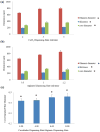Characterization of printable cellular micro-fluidic channels for tissue engineering
- PMID: 23458889
- PMCID: PMC4281173
- DOI: 10.1088/1758-5082/5/2/025004
Characterization of printable cellular micro-fluidic channels for tissue engineering
Abstract
Tissue engineering has been a promising field of research, offering hope of bridging the gap between organ shortage and transplantation needs. However, building three-dimensional (3D) vascularized organs remains the main technological barrier to be overcome. One of the major challenges is the inclusion of a vascular network to support cell viability in terms of nutrients and oxygen perfusion. This paper introduces a new approach to the fabrication of vessel-like microfluidic channels that has the potential to be used in thick tissue or organ fabrication in the future. In this research, we investigate the manufacturability of printable micro-fluidic channels, where micro-fluidic channels support mechanical integrity as well as enable fluid transport in 3D. A pressure-assisted solid freeform fabrication platform is developed with a coaxial needle dispenser unit to print hollow hydrogel filaments. The dispensing rheology is studied, and effects of material properties on structural formation of hollow filaments are analyzed. Sample structures are printed through the developed computer-controlled system. In addition, cell viability and gene expression studies are presented in this paper. Cell viability shows that cartilage progenitor cells (CPCs) maintained their viability right after bioprinting and during prolonged in vitro culture. Real-time PCR analysis yielded a relatively higher expression of cartilage-specific genes in alginate hollow filament encapsulating CPCs, compared with monolayer cultured CPCs, which revealed that printable semi-permeable micro-fluidic channels provided an ideal environment for cell growth and function.
Figures











Similar articles
-
Evaluation of cell viability and functionality in vessel-like bioprintable cell-laden tubular channels.J Biomech Eng. 2013 Sep;135(9):91011. doi: 10.1115/1.4024575. J Biomech Eng. 2013. PMID: 23719889 Free PMC article.
-
Fabrication and characterization of gels with integrated channels using 3D printing with microfluidic nozzle for tissue engineering applications.Biomed Microdevices. 2016 Feb;18(1):17. doi: 10.1007/s10544-016-0042-6. Biomed Microdevices. 2016. PMID: 26842949
-
Microfluidic Bioprinting of Heterogeneous 3D Tissue Constructs Using Low-Viscosity Bioink.Adv Mater. 2016 Jan 27;28(4):677-84. doi: 10.1002/adma.201503310. Epub 2015 Nov 26. Adv Mater. 2016. PMID: 26606883 Free PMC article.
-
Bioprinting toward organ fabrication: challenges and future trends.IEEE Trans Biomed Eng. 2013 Mar;60(3):691-9. doi: 10.1109/TBME.2013.2243912. Epub 2013 Jan 30. IEEE Trans Biomed Eng. 2013. PMID: 23372076 Review.
-
Bioprinting and its applications in tissue engineering and regenerative medicine.Int J Biol Macromol. 2018 Feb;107(Pt A):261-275. doi: 10.1016/j.ijbiomac.2017.08.171. Epub 2017 Sep 21. Int J Biol Macromol. 2018. PMID: 28870749 Review.
Cited by
-
3D Bioprinting for Vascularized Tissue Fabrication.Ann Biomed Eng. 2017 Jan;45(1):132-147. doi: 10.1007/s10439-016-1653-z. Epub 2016 May 26. Ann Biomed Eng. 2017. PMID: 27230253 Free PMC article. Review.
-
Advanced tumor organoid bioprinting strategy for oncology research.Mater Today Bio. 2024 Aug 8;28:101198. doi: 10.1016/j.mtbio.2024.101198. eCollection 2024 Oct. Mater Today Bio. 2024. PMID: 39205873 Free PMC article. Review.
-
Dental Materials Applied to 3D and 4D Printing Technologies: A Review.Polymers (Basel). 2023 May 22;15(10):2405. doi: 10.3390/polym15102405. Polymers (Basel). 2023. PMID: 37242980 Free PMC article. Review.
-
Stereolithographic printing of ionically-crosslinked alginate hydrogels for degradable biomaterials and microfluidics.Lab Chip. 2017 Oct 11;17(20):3474-3488. doi: 10.1039/c7lc00694b. Lab Chip. 2017. PMID: 28906525 Free PMC article.
-
Numerical analysis on the effects of microfluidic-based bioprinting parameters on the microfiber geometrical outcomes.Sci Rep. 2022 Mar 1;12(1):3364. doi: 10.1038/s41598-022-07392-0. Sci Rep. 2022. PMID: 35233043 Free PMC article.
References
-
- Lanza R, Langer R, Vacanti J. Principles of Tissue Engineering. 3. Elsevier; 2007.
-
- Melchels FPW, Domingos MAN, Klein TJ, Malda J, Bartolo PJ, Hutmacher DW. Additive manufacturing of tissues and organs. Progress in Polymer Science. 2012;37:1079–1104.
-
- Mondy WL, Cameron D, Timmermans JP, Clerk ND, Sasov A, Casteleyn C, Piegl L. 2009 Computer-aided design of microvasculature systems for use in vascular scaffold production. 2009;1:035002. - PubMed
-
- Lee W, Lee V, Polio S, Keegan P, Lee JH, Fischer K, Park JK, Yoo SS. On-demand three-dimensional freeform fabrication of multi-layered hydrogel scaffold with fluidic channels. Biotechnology and Bioengineering. 2010;105:1178–1186. - PubMed
Publication types
MeSH terms
Substances
Grants and funding
LinkOut - more resources
Full Text Sources
Other Literature Sources
Miscellaneous
